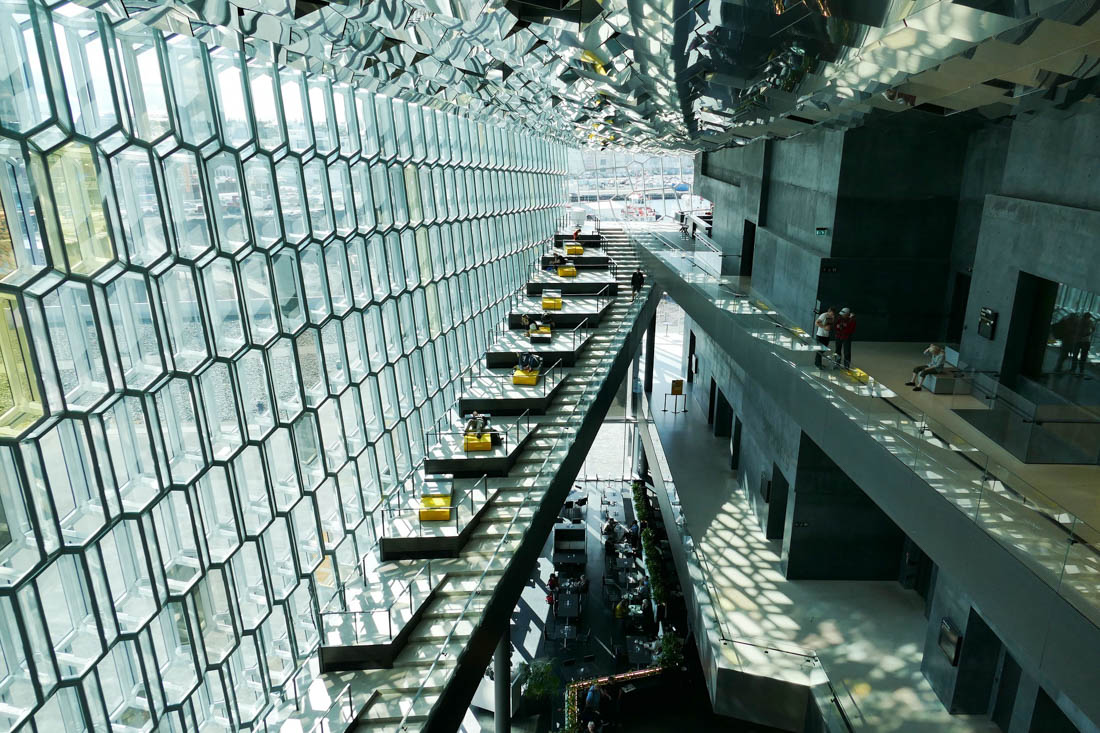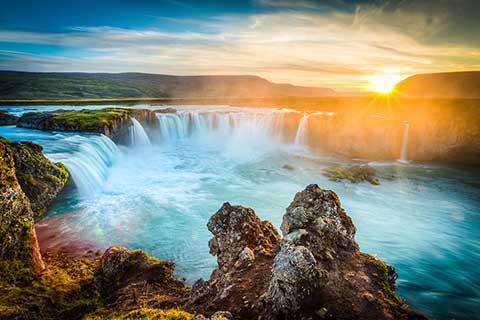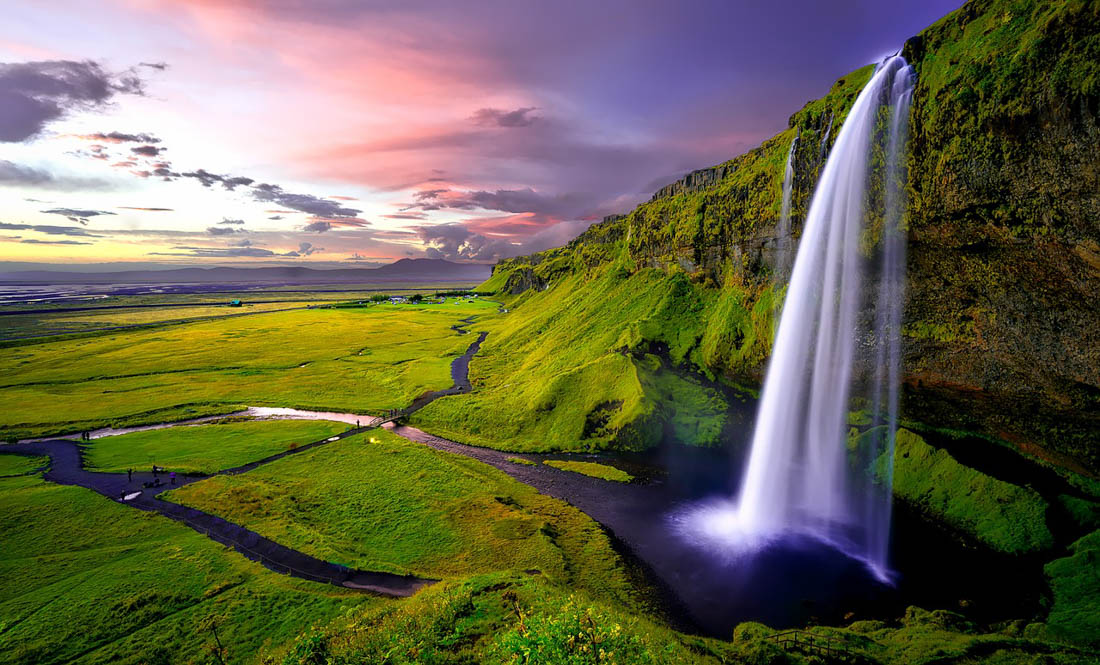Planning a trip to Iceland doesn't have to be difficult. Known for its beauty, culture, food, and exciting activities, this country is a stunning destination. Our travel cost guide will help you plan a perfect trip on your ideal budget. We've collected tons of travel cost data from previous travelers, and we're revealing average hotel prices and dining costs along with sightseeing and transportation tips. Now you'll be able to craft a memorable adventure without blowing your budget.
How much does it cost to travel to Iceland?
You should plan to spend around $230 (kr31,842) per day on your vacation in Iceland. This is the average daily price based on the expenses of other visitors.
Past travelers have spent, on average for one day:
- $58 (kr8,035) on meals
- $31 (kr4,249) on local transportation
- $190 (kr26,381) on hotels
A one week trip to Iceland for two people costs, on average, $3,213 (kr445,788). This includes accommodation, food, local transportation, and sightseeing.
All of these average travel prices have been collected from other travelers to help you plan your own travel budget.
-
One Week
Per person
$1,607
kr222,894
-
2 Weeks
Per person
$3,213
kr445,788
-
One Month
Per person
$6,886
kr955,260
-
One Week
For a couple
$3,213
kr445,788
-
2 Weeks
For a couple
$6,426
kr891,576
-
One Month
For a couple
$13,771
kr1,910,520
How much does a one week, two week, or one month trip to Iceland cost?
A one week trip to Iceland usually costs around $1,607 (kr222,894) for one person and $3,213 (kr445,788) for two people. This includes accommodation, food, local transportation, and sightseeing.
A two week trip to Iceland on average costs around $3,213 (kr445,788) for one person and $6,426 (kr891,576) for two people. This cost includes accommodation, food, local transportation, and sightseeing.
Please note, prices can vary based on your travel style, speed, and other variables. If you're traveling as a family of three or four people, the price per person often goes down because kid's tickets are cheaper and hotel rooms can be shared. If you travel slower over a longer period of time then your daily budget will also go down. Two people traveling together for one month in Iceland will often have a lower daily budget per person than one person traveling alone for one week.
A one month trip to Iceland on average costs around $6,886 (kr955,260) for one person and $13,771 (kr1,910,520) for two people. The more places you visit, the higher the daily price will become due to increased transportation costs.
Independent Travel
Traveling Independently has many benefits including affordabilty, freedom, flexibility, and the opportunity to control your own experiences.
All of the travel costs below are based on the experiences of other independent travelers.
Is Iceland expensive to visit?
Iceland is a moderately priced destination to visit. It's about average with most other countries for travel costs. The prices for food, accommodation, and transportation are all fairly reasonable.
Within Europe, which is known to be an expensive region, Iceland is moderately priced compared to the other countries. The overall cost of travel here is comparable to Denmark or the UK.
In Iceland, you'll find accommodation and activities that cater to both budget travelers and those seeking a more lavish experience. Budget accommodation options are available, such as hostels in Reykjavik and Akureyri, but there are also luxury hotels that cater to the more affluent customer, along with mid-range hotels for families or couples.
Iceland doesn't have to break the bank if you follow simple tips like eating at less expensive restaurants and enjoying free activities.
On average, budget travelers spend $100 (kr13,765) per person per day, mid-range travelers spend $232 (kr31,842) per day, and luxury travelers spend around $538 (kr73,959) per day. These costs are calculated from the expenses of previous travelers to Iceland.
For more details, see Is Iceland Expensive?
How much money do I need for a trip to Iceland?
The average Iceland trip cost is broken down by category here for independent travelers. All of these Iceland travel prices are calculated from the budgets of real travelers. Also, you can see more details at How much does a trip to Iceland cost?
Iceland on a Budget
|
Category
|
Budget
|
Mid-Range
|
Luxury
|
Accommodation 1
For 1 person in double occupancy
|
$39
(kr5,386)
|
$95
(kr13,191)
|
$222
(kr30,817)
|
|
Local Transportation 1
|
$13
(kr1,735)
|
$31
(kr4,249)
|
$72
(kr9,928)
|
|
Food 2
|
$24
(kr3,299)
|
$58
(kr8,035)
|
$133
(kr18,506)
|
|
Entertainment 1
|
$15
(kr2,148)
|
$42
(kr5,832)
|
$123
(kr17,032)
|
|
Alcohol 2
|
$3-10
(kr449-1,348)
|
$8-23
(kr1,060-3,181)
|
$16-48
(kr2,236-6,707)
|
 Reykjavik, Iceland
Reykjavik, Iceland
Realistic Expectations for Your Travel Budget
It's important to set realistic expectations about your travel budget. While many people consider themselves "budget" travelers, the truth is that most people don't find this shoestring travel style to be enjoyable. Consider what you genuinely appreciate on a trip and think about your previous travel experiences. Do you lean more towards staying in nice resorts, or mid-range hotels, or maybe even hostels? Is dining out in nice restaurants something you prioritize? Your answers will have a big impact on your overall travel budget.
The Truth on Budget Travel
People often say you can visit Iceland for just $100 daily, but unless you're okay with sacrificing many comforts, be ready to shell out a lot more.
Backpackers can typically make that budget work, but it usually requires sleeping in dorm-style hostels, eating at the most affordable restaurants or fast food spots, taking public transit or walking, and sticking to free sights.
Thankfully, Iceland offers a wide variety of hostels, with the largest selection found in Reykjavik and Akureyri.
Is Your Travel Style Average?
If you're on vacation as a couple or with family, you'll likely choose a mid-range hotel, eat at popular restaurants, and visit the must-see attractions, which often come with entry fees. Most travelers will want to visit the major sights, and landmarks. As most things cost money, it's best to expect a daily budget of about $232 per person.
Iceland has a wide selection of hotels and vacation rentals to fit any travel style. You'll likely be cutting your individual costs by sharing your hotel room with a partner, friends, or your kids. In family-friendly spots like Reykjavik, you'll come across plenty of hotels and restaurants designed with kids in mind. In Akureyri, check out Apt Hotel Hjalteyri, or consider Reykjavik Residence Apartment Hotel in Reykjavik. For couples visiting Isafjordur, check out Hotel Isafjordur for a romantic place to stay. For more family and couples options, see our hotel guide for Iceland here.
Want to Escape the Daily Grind in Style?
To experience a truly luxurious getaway, where everything from the service to the accommodation is elevated, plan for a daily price near $538. This means booking luxury hotels, dining in five-star restaurants, enjoying exclusive excursions, and hiring private drivers. You'll be vacationing among the wealthy in destinations like Hofn and Reykjavik. Or you could plan an multi-day adventure by booking a higher end tour such as 12 Days Grand Tour of Iceland - offered by GJ Travel.
Accommodation Budget in Iceland
Iceland offers hotels with a wide range of prices. You might be surprised at the difference between budget and high-end options, especially during peak season when prices increase significantly. To save, visit in the off-season, and book early for better deals.
Calculated from travelers like you
The average price paid in Iceland for two people for a typical double-occupancy hotel room is $190 (kr26,381). For one person sharing a room, the average price paid for a hotel room is $95 (kr13,191) per night. These costs are from the reported spending of actual travelers.
Looking for a hotel in Iceland? Prices vary by location, date, season, and the level of luxury. See below for options.
Reykjavik
In Reykjavik, which is a city, expect a fairly wide range of choices and prices for accommodation. Hotel prices here can range from $81 in the low season to $401 during the peak season. Reykjavik Residence Apartment Hotel ($136) is one of the best hotel options here, and Kvosin Downtown Hotel is also good, and starts at $177. You can expect to pay around $41 for a dorm bed if you decide to stay in a hostel. As many travelers typically stay for up to five days, ensure you find a cozy place in a good spot if you intend to explore for a while.
Local Transportation Budget in Iceland
Calculated from travelers like you
-
On average, past travelers have spent $31 (kr4,249) per person, per day, on local transportation in Iceland. The cost of a taxi ride or rideshare service (Uber/Lyft) in Iceland is significantly more than public transportation.
-
Local Transportation1
Taxis, local buses, subway, etc.
$31
kr4,249
With an outstanding train system, Iceland connects you to almost anywhere in the country. The prices are quite reasonable, and the rides are both fast and comfortable. When rail lines don't reach your destination, long-distance and regional buses can step in.
Many destinations around Iceland have limited options for public transportation unless you're visiting places like the biggest cities. You should plan to rent a car or have a prearranged form of transportation available, such as a tour. However, this may cut into your overall trip budget.
Planning to explore the countryside? You'll likely want to rent a car. Keep in mind that the average car in Europe has a manual transmission, and an automatic will come at a higher price. It's best to make your reservation early, as the cheaper options often sell out fast.
If you're bringing a car to a larger city, be sure to inquire about parking at your hotel beforehand. You may need to pay for parking either at the hotel or at a nearby garage. Finding a spot further from the city could save you some money.
Food Budget in Iceland
Calculated from travelers like you
-
While restaurant and meal prices in Iceland can vary significantly, the average cost of food in Iceland is $58 (kr8,035) per day, per person, based on the spending habits of previous travelers.
-
Food2
Meals for one day
$58
kr8,035
When dining out, the average daily cost for food in Iceland is about $58 (kr8035) per person. Previous travelers have typically spent from $24 to $135 per day. Generally, breakfast and lunch will cost less than dinner, but that will vary based on the type of restaurant and what you order.
Typical meal prices in Iceland are as follows:
- Breakfast: $11 to $18
- Lunch: $9 to $29
- Dinner: $20 to $47
- Coffee: $5
- Fast Food or Street Food: $9
Icelandic food has continued to evolve in recent decades. In the past the cuisine was dominated by lamb and fish as staples but in recent years the options have diversified significantly. It's still a difficult country to visit as a vegetarian, as most dishes include some form of meat, but there are now several vegetarian restaurants in the capital city, and a few vegetarian options are found on most menus.
Skyr: This is a dairy product that is local to Iceland and is similar to yogurt. It is found throughout the country and comes in both unflavored and flavored varieties.
Harofiskur: This is a popular snack throughout the country. It is made with dried pieces of fish that are served with butter. It's also a good accompaniment with coleslaw.
Pylsa: This fast food item, basically a hot dog, is usually served with fried onions or fresh ontion, ketchup, mustard, and remoulade. It's a good cheap option if you're looking for something filling and quick. It's found in most convenience stores or small shops around town.
Iceland is an excellent place to savor local cuisine, offering a wide selection of tasty dishes. Some of the top cities for food lovers include .
When traveling with children, look for restaurants with a kids menu. This can save you plenty of money as these options tend to be much lower in price. Some restaurants don't list the kids' options on their menu, so ask the waiter before you order.
While numerous hotels include breakfast in the overall cost, some might add it as an additional fee. The quality and pricing of breakfast can fluctuate based on the hotel. Knowing this information in advance can guide your decision on whether to indulge in a hotel buffet or opt for a cheaper bakery or café nearby.
Carrying a water bottle instead of buying drinks can help you save money while also being good for the environment.
If a tour is on your agenda, be sure to confirm which meals are covered beforehand. Paying for some food out of pocket can really add to your travel expenses.
If you want to experience the culture in Iceland, a food tour or cooking class is a great way to do it. After all, cuisine is one of the reasons why so many people visit. A few of the best culinary activities here include:
- Reykjavik Food Tour and City Walk - PRIVATE TOUR for $295 details
- Kopar Fine Dining Dinner and Northern Lights Cruise from Reykjavik for $182 details
- Private Vegetarian Reykjavik Food Tour for $195 details
- Private Reykjavik Christmas Food Tour for $215 details
Below are some standard food costs in Iceland, gathered from real travelers. These prices should give you a general idea of what you can expect to spend on dining and meals. Keep in mind, though, that your own costs may differ depending on your taste in restaurants, travel habits, and menu choices.
-
Dinner (Fish Market)
kr24,852
Sightseeing and Activities Budget in Iceland
Calculated from travelers like you
-
Sightseeing activities, entertainment, and entrance tickets in Iceland typically cost an average of $42 (kr5,832) per person, per day based on the spending of previous travelers. This includes fees paid for admission tickets to museums and attractions, day tours, and other sightseeing expenses.
-
Entertainment1
Entrance tickets, shows, etc.
$42
kr5,832
Iceland attracts a large number of travelers and offers plenty of chances to see world-famous locations. Some of the most visited sites in Iceland are Reykjavik.
Reykjavik
Reykjavik is the capital and largest city in Iceland. It makes a good starting point for exploring the country, but many people head quickly into Iceland's countryside, as that is what the region is known for. In town you'll find the National and Saga Museums, which offer a fascinating overview on the country's Viking past. Just outside of town is the world famous Blue Lagoon Spa, which is in the town of Grindavik. The city has a thriving nightlife scene that is centered around its many festivals.
A nice way to explore destinations in Iceland is with local tours that last just a few hours. This way you can see as much as possible in an efficient way with knowledgable guides. Prices vary by the type of activity or tour, the dates, and the size of the group. Here are a few of the highest rated tours by previous visitors:
- Boat Tour in Vestmannaeyjar for $96 details
- 3hr Volcanic Springs ATV Adventure from Reykjavik for $299 details
- Midnight Sun Kayaking Adventure by Mt. Kirkjufell for $133 details
- The Viking Horse Riding Experience in North Iceland for $102 details
Outlined below are some typical prices for entry fees and activities in Iceland. They have been reported from the expenses of previous travelers. These costs provide an idea of what you might need to spend, though your individual expenses will depend on the activities you participate in, the places you visit, and how often you choose budget-friendly or free activities.
-
Art Museum
kr1,500
-
Wine and Spa
kr4,079
Nightlife Budget in Iceland
Calculated from travelers like you
-
The average person spends about $15 (kr2,121) on nightlife and alcoholic beverages in Iceland per day. The more you spend on alcohol, the more fun you might be having despite your higher budget.
-
Alcohol2
Drinks for one day
$15
kr2,121
Iceland is an exciting destination for nightlife, offering a diverse range of bars, clubs, and parties. Some of the top cities for nightlife enjoyment include Reykjavik.
Reykjavik
Reykjavik is one of the best nightlife destinations in Iceland. The city offers the best nightlife in Iceland and you'll be surprised at the number of clubs, bars, and craft breweries that you can choose from. Almost all of the popular nightlife spots are around Laugavegur, a major shopping street in town.
Nightlife is often a highlight, but cutting back on alcohol can help you stay within your travel budget.
Nightlife activities and tasting tours are popular in Iceland. A few favorites from other travelers include:
- Gin Distillery tour and tasting for $35 details
- Arctic Coastline, Microbrewery and Culture Tour for $247 details
- Reykjavik: Eimverk Distillery Guided Tour with Tasting for $32 details
- Beer & brewery tour at Gaedingur Brewery for $37 details
Here are some typical drink and nightlife prices in Iceland, drawn from the experiences of past travelers. These costs can give you a general sense of what to expect, though your own spending will differ based on how often you enjoy alcoholic beverages and how much you consume. Remember, one of the most effective ways to reduce your travel costs is to limit alcohol consumption.
Travel Costs Last Updated: Dec 31, 2023
Traveling in Iceland
 Godafoss Waterfall
Godafoss Waterfall
Iceland is a beautiful country in the North Atlantic ocean. About ten percent of the country is covered by glaciers and natural beauty is abundant throughout the countryside. There are also many geothermal hotspots around the island.
Iceland is very close to the Arctic Circle, so it is important to consider what time of year you plan to visit. The days can be long in the summer, and very short in the winter. During June, the sun only sets briefly and it never gets completely dark. Alternatively, in December there are almost 20 hours of darkness. During the equinoxes in March and September, the days and nights are approximately the same length and comparable to elsewhere in the world. Despite Iceland's proximity to the Arctic Circle, the climate is not as cold as you might expect. In fact, Iceland is a great place to visit in November.
Most visitors to Iceland choose to rent a car. This allows for the most flexibility and lets you see the beautiful countryside at your own pace. Most of the popular sites throughout the country are easily accessible with good roads, but if you hope to get a little more off the beaten track, consider renting a four wheel drive vehicle. These cars can be in high demand so plan well in advance.
If you're not interested in renting a car, you can usually book excursions through tour companies in either Reykjavik or Akureyri. These can be expensive, but will allow you access to the country's most impressive volcanoes and glaciers.
At A Glance
- The official language of Iceland is Icelandic. It is not uncommon for Icelanders to also speak English and Danish, both of which are taught from an early age in schools. It is still respectful to attempt to speak some Icelandic before referring to English. These efforts will be much appreciated. If you learn a few phrases ahead of time, you'll be well respected for your efforts.
- Krona is the local currency in Iceland. It is recommended that you buy and sell krona in Iceland, where you will get the best exchange rate. Most business accept credit cards. Credit cards are also accepted by taxis and souvenir stands, so you really don't need to carry a lot of cash with you. Keep in mind that this country can get expensive, so here are some tips for budgeting in Iceland.
- If you're looking to buy some interesting, local products, consider purchasing items made from Icelandic wool. The Icelandic sheep is unique and makes a soft but durable wool that is woven into hats, gloves and more. Other interesting local items include arts and crafts such as musical baskets and porcelain sculptures that can be found at the local craft shops.
- Winters are surprisingly mild in Iceland. There is a maritime temperate climate and the winters are somewhat comparable to those in New England. Do be aware that the weather conditions can change rapidly. Although winters can be warmer than you might expect, summers are also quite cool, so come prepared for temperatures around 20 degrees Celsius during these months.
- A favorite activity in Iceland is to go hiking. Some of the hiking is quite intense so come prepared with good walking boots and some food. Also, be prepared for the changing weather conditions as a beautiful day may suddenly be interrupted by a strong storm, particularly during the winter months.
Related
Traveling independently and looking for a
hostel in Iceland?
Are you organizing group travel and need a place to stay in Reykjavik?
Find a Contiki tour to Europe.
Top Tourist Attractions
The Blue Lagoon: This is a world famous Geothermal Spa in the southwestern part of Iceland. It is halfway between Keflavik Airport and Reykjavik, near the town of Grindavik. Its warm, mineral rich waters are the result of the nearby Svartsengi geothermal power plant. Bathing in this pool is a popular activity for almost all visitors to Iceland.
The Gullfoss Waterfall: Also called Golden Falls, this 32 meter high double waterfall is found along the White River. It is typically largest in the summer when the rains and glacial runoff are at their peak. It's also the largest volume waterfall in Europe. You can drive yourself to the falls, or take one of the many tours along the Golden Circle.
Geysir: This hot spring is the namesake for all geysers around the globe. It's also one of the most popular destinations in the country. Nearby are several other geysers which erupt more frequently, as well as some impressively colored hot pools.
We've been gathering travel costs from tens of thousands of actual travelers since 2010, and we use the data to calculate average daily travel costs for destinations around the world. We also systematically analyze the prices of hotels, hostels, and tours from travel providers such as Kayak, HostelWorld, TourRadar, Viator, and others. This combination of expenses from actual travelers, combined with pricing data from major travel companies, gives us a uniqe insight into the overall cost of travel for thousands of cities in countries around the world. You can see more here: How it Works.
 Godafoss Waterfall
Godafoss Waterfall



 Budget Your Trip is all about finding out how much everything costs so that you can travel cheaper and longer. Created by avid travelers Laurie and Bryan, our goal is to help you plan your next trip on the right budget. With average daily travel costs that are calculated from the budgets of real travelers, plus an analysis of hotel and tour prices, you can find out how much money you need to plan your next adventure. We also have plenty of travel advice, accommodation reviews, and activity suggestions.
Budget Your Trip is all about finding out how much everything costs so that you can travel cheaper and longer. Created by avid travelers Laurie and Bryan, our goal is to help you plan your next trip on the right budget. With average daily travel costs that are calculated from the budgets of real travelers, plus an analysis of hotel and tour prices, you can find out how much money you need to plan your next adventure. We also have plenty of travel advice, accommodation reviews, and activity suggestions.